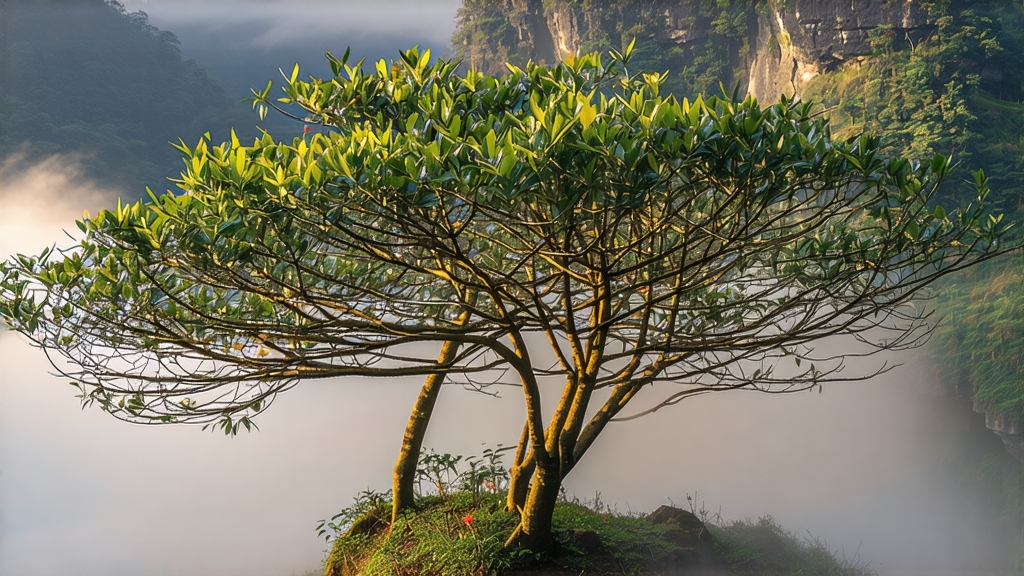
Tucked away in the cloud-veiled peaks of Mengding Mountain, Sichuan Province, Mengding Huangya has been whispering its golden story for more than twelve centuries. To most tea lovers outside China it remains a quiet legend, overshadowed by green tea and pu-erh, yet within the tiny pantheon of yellow teas it is the most venerable and elusive. This essay invites the international reader to meet the “Imperial Yellow Bud,” tracing its birth in Tang-dynasty monasteries, its meticulous craft of “sealed yellowing,” and the almost ritualistic way it is infused and savored today.
-
Historical tapestry
Mengding Mountain rises 1 450 m above the Chengdu plain, perpetually wrapped in humid mist that filters sunlight into a soft, diffused glow—ideal for slow-growing tea bushes. Buddhist monks began planting tea here around AD 724, and by 815 the Tang court had already registered Mengding tea as tribute. A Song-era edict (1107) explicitly demanded “one hundred cakes of Mengding Huangya, wrapped in damask, to arrive before Qingming.” When the Ming emperor Hongwu simplified tribute regulations in 1391, he surprisingly retained only two items: Mengding Huangya and Longjing, proof of its unrivaled status. Caravans carried the compressed cakes westward to Tibet and eastward to Kaifeng, giving Mengding Huangya the dual identity of both imperial luxury and frontier currency. After the fall of the Qing, production lapsed; the craft survived only because a handful of hereditary tea masters continued to hand-fry tiny batches for local temples. Full-scale revival did not occur until 1956, when the Sichuan Tea Company reconstructed the yellowing rooms based on oral memory and one surviving bamboo basket. -
Micro-terroir and cultivar
The mountain’s red-yellow sandy loam is rich in potassium and selenium, while the annual 2 000 mm of precipitation arrives in gentle night rains that wash the leaves but do not erode the buds. The indigenous cultivar, known locally as “Mengding small-leaf yellow shoot,” develops an unusually high ratio of soluble sugars to polyphenols, creating the honeyed finish that later distinguishes the tea. Farmers insist that only buds picked between the solar terms “Waking of Insects” (early March) and “Grain Rain” (late April) possess the right balance; any earlier and the amino acid content is too low, any later and the astringency rises sharply. -
Craft: the art of “men huang” (sealed yellowing)
Yellow tea’s defining step is a second, gentle fermentation after kill-green, a phase Chinese artisans call men huang—“sealing yellow.” Mengding Huangya is the benchmark against which all other yellow teas are judged, and its protocol is ruthlessly precise.a. Plucking: one bud plus one just-unfolding leaf, 2.0–2.2 cm in length, 0.3 g in weight.
b. Withering: spread on bamboo trays for 90 minutes at 18 °C to reduce moisture to 68 %.
c. Kill-green: wok-fired at 140 °C for four minutes, during which the master tosses the leaves 320 times; the wrist motion resembles drawing the Chinese character “zhi.”
d. Initial rolling: light pressure for eight minutes to break 35 % of cell walls without squeezing juice.
e. First piling: the semi-damp leaves are wrapped in steamed cotton cloth and placed inside a paulownia box; the core temperature is maintained at 28 °C for 24 hours. Oxidative enzymes convert chlorophyll into pheophytin while catechins dimerize, giving the future liquor its amber hue.
f. Re-firing: the now yellow-green leaves are dried at 80 °C to 50 % moisture.
g. Second piling: a tighter wrap, 18 hours; yellow spots appear on the bud tips.
h. Final drying: charcoal-baked over three layers of low-temperature ash (60 °C, 50 °C, 40 °C) until moisture falls to 5 %. The entire cycle spans 72 hours and demands that the master never sleep more than 30 minutes at a stretch. -
Appearance and aroma
Finished Mengding Huangya resembles slender golden needles, each bud tipped with